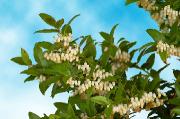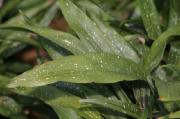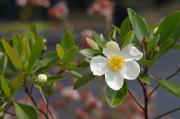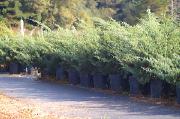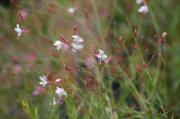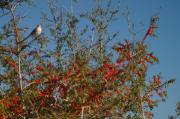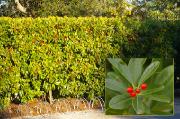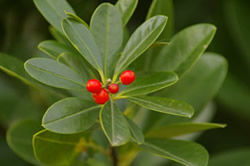
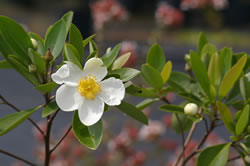
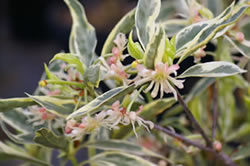
Find plants by
Find plants by
Find plants by
Find
plants by
This
list includes our basic inventory by botanical name. Although you can
get all of the plants some of the time, and some of the plants all of
the time, all of the plants are not necessarily ready all of the time.
Our current availability is right here.
Click
on any photo to see a larger image. These are reference photos taken by
Thayer over the years and are not necessarily what the plants look like
right now. Because there are a lot of photos, even if thumbnail size,
this page may take a bit to load.
To see all the photos, our
gallery is right here.
Find plants by
| Photo (click for larger image) |
Botanical Name |
Common Name |
Light
Needs |
N=Native
B=Butterflies H=Hummers
B=Birds Notes by Tom Dodd,III ©2010-2013 Zone; Height; Light; Soil; Misc. |
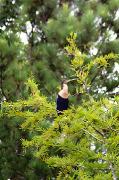 |
Taxodium ascendens | Pond Cypress | see Taxodium distichum nutans | |
| Selanginella draussiana | Spikemoss | |||
| Ardisia japonica | Ardisia | A very bad groundcover that is very invasive and isn't controlled by Roundup. Should never be planted as will escape into the woods and replace the native plants that feed the native animals. | ||
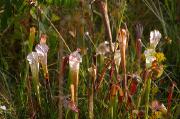 |
Sarracenia | Pitcher plants | N These carnivorous plants grow in one of the most unusual habitats on earth. They are rich in diversity and strange creatures. We do these from seed occasionally. Over 90% of the bogs have been lost to development and stupidity. They are available as tissue culture plugs from some companies, but I prefer to grow the real thing. | |
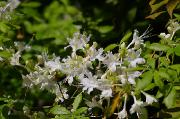 |
Rhododendron alabamense | Alabama Azalea | N This plant is found in northwest Alabama and adjacent regions and has white flowers with a yellow blotch on the flag petal. It is one of the most fragrant of all the azaleas and blooms in the early spring | |
| Hydrangea
quercifolia 'Ellen Huff' |
Hydrangea
Oakleaf 'Ellen Huff' |
N A cultivar very well suited for the deep south that will do well from Mobile to north of Atlanta. | ||
| Hydrangea
serrata 'Fuji Waterfall' |
Hydrangea
'Fuji Waterfall' |
part
|
For the best description see the USDA one here. | |
| Hydrangea
quercifolia 'Pee Wee' |
Hydrangea Oakleaf 'Pee Wee' |
part
|
N
A cultivar that is smaller than the species and is suitable for smaller
natural areas. Z-6; H-3'; part sh; dry; white flowers |
|
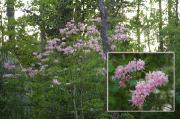 |
Rhododendron canescens | Piedmont
Azalea or Honeysuckle Azalea |
part
|
N This azalea is found in the mid to lower south and blooms with light pink fragrant flowers in the early spring. |
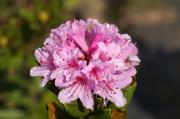 |
Rhododendron Chapmanii | Chapman's Rhododendron |
part
|
N This endangered evergreen Rhododendron is found in only a few spots in the area around Port St. Joe, Florida. It has pink flowers and is the only evergreen Rhododendron that can handle the heat of the lower south. It likes shade and good drainage and will get to 6 or 8 feet tall and almost as wide. Hard to propagate from cuttings, we grow them from seed from mature plants at home. We like this plant but must warn you that it is very particular as to site. Two interesting hybrids of R. chapmanii and R. formosanum have been selected by John Thornton in Louisiana and they do well in our area. 'Willow Run' is a light pink flowered form and 'Will O' the Wisp' has white flowers. |
| R.
chapmanii x R. formosanum 'Willow Run' |
part
|
see
above H-8'; part shade; dry; evergreen; light pink flower |
||
| R.
chapmanii x R. formosanum 'Will O' the Wisp' |
part
|
see
above H-8'; part shade; dry; evergreen; white flower |
||
| Rhododendron flammeum (syn. R. speciosum) | Oconee Azalea |
part
|
N This plant is found naturally in the area of Georgia around the Oconee River. The flowers are not fragrant but the color range in this species is amazing. In the same population, you can find red, orange, yellow, and all the colors in between. There are some named cultivars that have been selected for a particular flower color but most of our customers want the orange types (maybe they are Auburn fans). Dad found a double flowered form many years ago that he named 'Double Pleasure' but we all think it is a hybrid as it does have some fragrance. | |
| Rhododendron oblongifolium | Texas Azalea |
part
|
N This is a white flowered form that is found in east Texas. We still use this name although some botanists had grouped most of the white azaleas (R. oblongifolium, R serrulatum, R. viscosum, and R. atlanticum) into the same species. What I want to know is this: How is a R. viscosum from Cape Cod like a R. serrulatum from Mobile? They don't even talk alike. We believe that, if you want a white native azalea, you should get the form that does well in your area. That's why we keep the old names. | |
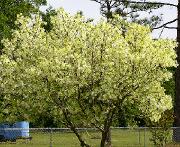 |
Chionanthus virginicus | Fringe Tree or Grancy Grey Beard |
part
|
N
A bit more delicate than it's Chinese cousin and much harder to propagate,
thus the difference in price and availability. If you see one at a
nursery, get it. This is a plant that should not be dug out of its'
native habitat as it is very hard to transplant from the woods. Country
folks know a good thing when they see it as you will notice if you
enjoy a spring ride in the country. Z-6; H-10'; part sh; dry; creamy, fringe-like |
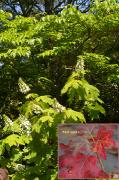 |
Hydrangea quercifolia sp. | Hydrangea Oakleaf |
part
|
N
Southeast U.S. from mountains to south Alabama and adjacent states.
Large leaves lobed like an oak (Quercus is Latin for oak, folia is
Latin for leaves) with white flowers in large pyramidal clusters.
Several cultivars are grown and most are adaptable to the area from
which they originated. They prefer shade and drainage. Even when the
leaves have turned beautiful colors in the fall, the flowers persist
and can be used in dried arrangements. It is now the state wildflower
of Alabama (it is native to all counties of the state) and a must-have
plant for the natural garden. Z-6; H-5'; part sh; dry; white flowers |
| Hydrangea macrophylla 'Nikko Blue' | Hydrangea 'Nikko Blue' |
part
|
Favorite
of gardeners for years. Arguments rage about why they bloom blue or
pink and how to change that. Sun to part shade. Good drainage. Z-6; H-4'; part sh; dry; blue/pink flowers |
|
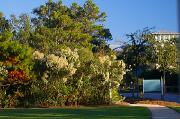 |
Baccharis
halimifolia |
Groundsel or Woody Aster |
N
Large shrub/small tree, member of the aster family. Blooms in October,
white. Normally found near water. Easy to grow as will thrive anywhere.
Salt tolerant. Native to most of the Gulf and East coasts. Don't get
this plant unless your wife says you can have it. Z-7; H-10'; s/sh; wet/dry |
|
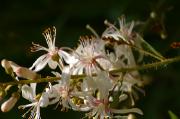 |
Bejaria
racemosa |
Tar Flower |
s/sh
|
N Z-7; H-3'; s/sh; dry; evergreen |
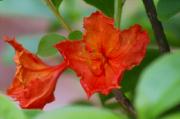 |
Rhododendron x 'Gen. Robert E. Lee' | Rhododendron x 'Gen. Robert E. Lee' |
s/sh
|
N The closest we have gotten to red. Hardest to grow. A hero to all southerners. There is a waiting list for this one. |
| Rhododendron x 'Pvt. Lafayette Acree' | Rhododendron x 'Pvt. Lafayette Acree' |
s/sh
|
N Ruffled orange. Named for Tom's ancestor that was a hero during the "recent unpleasantness". He and two other privates captured Gen. Crittington and his entire staff at the beginning of the war. When asked about his time in the army in his later years, he said "I never believed in secession anyway". | |
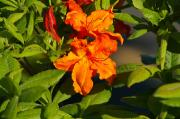 |
Rhododendron x 'Nathan Bedford Forrest' | Rhododendron x 'Nathan Bedford Forrest' |
s/sh
|
N Orange. Named for the best General from the South during the "recent unpleasantness". He got a bad rap later for starting the KKK but they kicked him out because he was against their racist stupidity. |
| Rhododendron x 'Maj. Leroy Broun' | Rhododendron x 'Maj. Leroy Broun' |
s/sh
|
N Deep orange. Named for a Confederate officer who later became President of Auburn University. | |
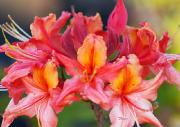 |
Rhododendron x 'J.E.B. Stuart' | Rhododendron x 'J.E.B. Stuart' |
s/sh
|
N Pink with yellow flag, much like 'Col Mosby' but blooms later. (Remember, Stuart was late getting to Gettysburg.) |
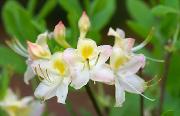 |
Rhododendron x 'Frederick O. Douglass' | Rhododendron x 'Frederick O. Douglass' |
s/sh
|
N Soft Pink. Bob Schwindt probably wouldn't go along with this name, but I consider him a southern (Maryland) hero and one of the greatest orators of all times. |
| Buxus microphylla japonica | Boxwood |
s/sh
|
This
small leaved species of Buxus is about the only type that does well
in the very deep South. While it will do well in Atlanta, other species
can thrive there but not in Mobile. The three major cultivars are
'Korean', 'Japanese', and a darker green form called 'Wintergreen'.
Most of these types are used for low, dense hedges and will attract
all the male dogs in the area. Z-7; H-3-5'; s/sh; dry; evergreen |
|
| Buxus microphylla 'Wintergreen' | Boxwood 'Wintergreen' |
s/sh
|
See
above. Z-7; H-3-5'; s/sh; dry; evergreen |
|
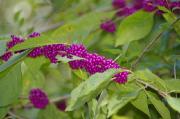 |
Callicarpa americana | Beautyberry |
s/sh
|
NB
Deciduous small shrub native from Virginia to Texas. Can be up to
6 feet and is known primarily for lots of purple berries in the fall.
Birds love the berries and it is great in fall flower arrangements.
Likes some shade and good conversation. Small, light pink flowers; lots of bright, purple berries. Z-6; H-6'; s/sh; dry |
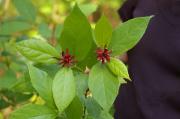 |
Calycanthus floridus | Sweet Shrub |
s/sh
|
N This shade-loving shrub is native from Virginia to Florida. The leaves are fragrant and many forms have fragrant flowers also. Neat blooms in spring and seed pods in the fall. A southern heirloom, passed down from mother to daughter through the generations |
| Camellia japonica | Camellia japonica |
s/sh
|
There are many cultivars of this favorite winter blooming evergreen shrub from Japan. While most of them grow in the deep south, there are some hybrids that will grow well above Atlanta. These plants first came into the U.S. thru Charleston in the late 1700's. Some of the ones we grow are listed below with some major characteristics. | |
| Camellia japonica 'Debutante' | Camellia japonica 'Debutante' |
s/sh
|
Large,
peony blooms are soft pink. Late. Z-7; H-8'; s/sh; dry; evergreen |
|
| Camellia japonica 'Gunsmoke' | Camellia japonica 'Gunsmoke' |
s/sh
|
Large
semi-double, red with pronounced yellow stamens. Late. Z-7; H-8'; s/sh; dry; evergreen |
|
| Camellia japonica 'Ira Mathewes' | Camellia japonica 'Ira Mathewes' |
s/sh
|
Z-7; H-8'; s/sh; dry; evergreen | |
| Camellia japonica 'Professor Sargent' | Camellia japonica 'Professor Sargent' |
s/sh
|
Red,
peony, fragrant. Late. Z-7; H-8'; s/sh; dry; evergreen |
|
| Camillia sasanqua | Camillia sasanqua |
s/sh
|
This species of Camellia blooms in the fall. While not as fit for cut flowers as the C. japonica types, they make up for it by the profussion of blooms and many are pleasantly fragrant. Many varieties and hybrids are available and we are adding some of Dad's to the list as we go along. | |
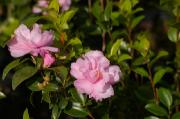 |
Camillia sasanqua 'Cotton Candy' | Camillia sasanqua 'Cotton Candy' |
s/sh
|
Upright,
light pink flowers Z-6; H-9'; s/sh; dry; evergreen |
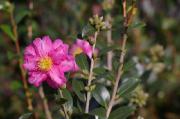 |
Camillia sasanqua 'Kilimanjaro' | Camillia sasanqua 'Kilimanjaro' |
s/sh
|
Z-6; H-9'; s/sh; dry; evergreen |
| Camillia
sasanqua 'Leslie Ann' |
Camillia
sasanqua 'Leslie Ann' |
s/sh
|
Formal
double, white with dark pink edge. Profuse bloomer. Columnar. Fall Z-6; H-9'; s/sh; dry; evergreen |
|
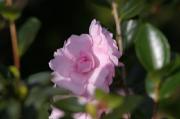 |
Camillia
sasanqua 'Pink Snow' |
Camillia
sasanqua 'Pink Snow' |
s/sh
|
semi-double,
soft pink, fragrant, Fall. Z-6; H-9'; s/sh; dry; evergreen |
| Camillia sasanqua 'Sparkling Burgundy' | Camillia sasanqua 'Sparkling Burgundy' |
s/sh
|
Purple/red,
peony. Fall. |
|
| Rhododendron x 'Emma Sansom' | Rhododendron x 'Emma Sansom' |
s/sh
|
N Soft pink and yellow. This lady had the courage to lead the southern troops through difficult terrain and attack the Yankees from the rear. | |
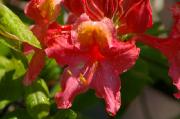 |
Rhododendron x 'Col. Mosby' | Rhododendron x 'Col. Mosby' |
s/sh
|
N Pink with yellow flag. Col. Mosby was know as the "Gray Ghost' because of his ability to attack, cause trouble, and then disappear. |
| Chasmanthium latifolium | River Oats |
s/sh
|
N The first cousin to "Sea Oats" is found in damp, shady areas along rivers and creeks from Pennsylvania to Florida over to Mexico. Will adapt to most soil types and is beautiful, especially in the wind. | |
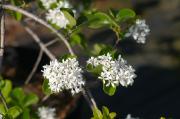 |
Chionanthus retusus | Fringe Tree, Chinese |
s/sh
|
Small
tree that covers with white blooms in the spring. It is the cousin
to our native "Fringe Tree" and is a bit easier to grow
in the sun here. Z-5; H-20'; s/sh; dry |
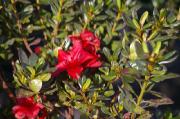 |
Azalea 'Midnight Flare' | Azalea 'Midnight Flare' |
s/sh
|
Aromi
hybrid, medium, red, mid-season. Z-7; H-3'; s/sh; dry; evergreen |
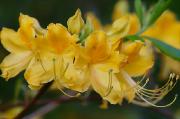 |
Rhododendron x 'Admiral Semmes' | Rhododendron x 'Admiral Semmes' |
s/sh
|
N Solid yellow. The easiest to grow. Admiral Semmes was skipper of the CSS Alabama and he still holds the record for number of enemy ships sunk or captured. Our hometown is named for this hero. |
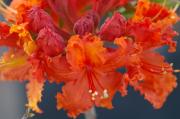 |
Rhododendron x 'Admiral Franklin Buchanan' | Rhododendron x 'Admiral Franklin Buchanan' |
s/sh
|
N Deep orange Named for the skipper of the CSS Virginia (Merrimac) and later Admiral in charge of Mobile Bay. |
|
Rhododendron |
Rhododendron 'Confederate Series' |
s/sh
|
N The Confederate Series of Native Azaleas were selected from a cross of Rhododendron austrinum and Rhododendron x 'Hotspur Yellow'. This cross was made by Bob Schwindt, the seed were planted by Dad and Tom III made the evaluations and named them per Mr. Schwindt's request. We had always loved the Exbury Azaleas but they can't take the heat of the deep south. The R. austrinum blood gives them the heat tolerance and vigor that we need here. Below is a list with the colors, etc. Most of them are difficult to propagate and grow, but do well once they are planted in semi-shade with good drainage. | |
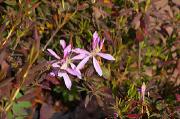 |
Azalea 'Koromo Shikibu' | Azalea 'Koromo Shikibu' |
s/sh
|
Lavender
with star shaped flowers, early, medium, repeat blooms if it likes
you. Z-7; H-5'; s/sh; dry; evergreen |
| Azalea 'Mrs. G. G. Gerbing' | Azalea 'Mrs. G. G. Gerbing' |
s/sh
|
White,
early, large (not as large as 'Formosa') Z-7; H-6'; s/sh; dry; evergreen |
|
| Azalea 'Formosa' | Azalea 'Formosa' |
s/sh
|
The
most popular Southern Indica, large, purple, early. Z-7; H-6'; s/sh; dry; evergreen |
|
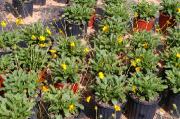 |
Coreopsis nana | Tickseed, Dwarf |
s/sh
|
NB
Spring yellow blooms on evergreen clumps. Will repeat bloom in the
shade and spread. Z-7; H-6in; s/sh; wet/dry; evergreen; yellow flowers |
| Azalea 'Conversation Piece' | Azalea 'Conversation Piece' |
s/sh
|
This
Robin Hill Azalea has large flowers in pink, pink and white, and white.
A mid-season to late bloomer with repeat blooms until fall. Medium
grower. Easy to see where it got its' name. Z-6; H-3'; s/sh; dry; evergreen |
|
| Azalea
'Chinsoi' |
Azalea
'Chinsoi' |
s/sh
|
Sharp
pink, late, small grower, satsuki type, repeat bloomer. Z-6; H-2'; s/sh; dry; evergreen |
|
| Azalea
'Amy' |
s/sh
|
Soft
pink flowers, mid-season, medium grower. A seedling of Azalea Glacier
(Glendale) selected by Tom Dodd, Jr. |
||
| Rhododendron austrinum 'Halo' | Florida
Flame Azalea 'Halo' |
s/sh
|
N
see
above H-10'; s/sh; dry; flowers yellow/orange |
|
| Rhododendron austrinum 'Escatawpa' | Florida
Flame Azalea 'Escatawpa' |
s/sh
|
N Typical of the species found in our local area, this plant was chosen by Arnell Blackwell and named by Uncle Bill Dodd and my Dad, Tom Dodd, Jr., for the river where it was found. It blooms in the early spring with fragrant, yellow to orange blooms. It is the most vigorous grower and was used as a parent plant in the Confederate series of native azaleas. | |
| Rhododendron austrinum 'Cheerleader' |
Florida Flame Azalea 'Cheerleader' |
s/sh
|
This plant was picked by Thayer out of a group of R. austrinum seedlings for the beautiful, yellow, fragrant "pom pom" flower heads. | |
|
Azaleas |
Azaleas
- general comments |
s/sh
|
There are several thousand cultivars ("cultivated varieties") of Azaleas and the best reference for all of them is Fred Galle's book "Azaleas" We only grow a few of the ones we like and if you would prefer other types, we would suggest that you refine your taste. While Azaleas will grow in the full sun, they prefer some shade late in the day. | |
|
Rhododendron- general |
Rhododendron |
s/sh
|
N This group of plants is Tom's favorite and why we are still poor. The deciduous forms are difficult to root, difficult to grow, but easy to establish if done properly. Most will grow in the sun and flower better, but when done so, need more care at first. We grow many of the native species of our region and many hybrids of the group. Most all of them like morning sun, afternoon shade, good drainage, and classical music. | |
| Phlox paniculata | Phlox, Garden |
s/sh
|
NB Southern favorite for 3ft late summer blooms in full sun or part shade. Varieties available change often, please call us. | |
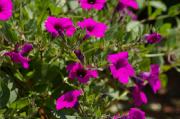 |
Petunia integrifolia |
Petunia, Violet-flowered |
s/sh
|
Native of Brazil. Evergreen here. Groundcover or hanging baskets. |
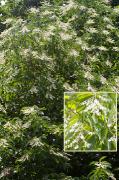 |
Oxydendrum arboreum | Sourwood |
s/sh
|
N
This
is one of the few native southern trees that has real decent fall
color. In the deep south, it prefers a little shade as it is an understory
tree there but in the upper portions of its range, it can take more
sun and will generally grow to a larger tree. When purchasing this
tree, one should be careful to obtain one from near your planting
site to best insure good growth and fall color. Trees from a few hundred
miles north don't like to move too far south (like Kalmia latifolia
and Cornus florida) but they will move north with less complaints
than I would make. The "Sourwood" has long spikes of small
while blooms in the summer and they persist as seed pods until late
fall. Thus, you could say that it has multi-seasonal interest. Z-6; H-20'; s/sh; dry; white flowers |
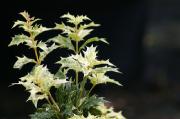 |
Osmanthus
heterophyllus 'Goshiki' |
Osmanthus
'Goshiki' |
s/sh
|
A
variegated, slow-growing shrub that comes to us from Japan. It is
evergreen (ever-variegated) and will draw attention to a semi-shady
spot. As its name suggests, the leaves are spiny (not sticky) like
a few other members of the Olive family and the new pink foliage in
the spring is attractive. |
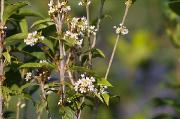 |
Osmanthus fragrans | Osmanthus, Sweet Olive |
s/sh
|
This
is an old southern favorite with nice evergreen foliage that makes
a nice large shrub. It is a member of the olive family and each time
it blooms it fills the whole garden with a wonderful fragrance. The
flowers are white and very small but you can always tell when it is
blooming. Z-7; H-15'; s/sh; dry; evergreen; white flowers |
| Magnolia virginiana australis | Magnolia, Bay |
s/sh
|
N
The
southern (or australis) form of "Bay Magnolia" is evergreen
and can get to be a rather large tree. It has white blooms in the
early summer and is normally found near, but not in, swamps and bays.
When the wind is blowing, you can see the silver undersides of the
leaves and they will add another dimension to the landscape. Z-6; H-30', s/sh, wet/dry, evergreen; white flowers |
|
| Gardenia
jasminoides - general |
Gardenia |
s/sh
|
There are many cultivars of this very fragrant plant. There are different leaf forms, different height forms, and different bloom times. We grow four cultivars and they are listed below and all have white flowers that will last longer with a bit of afternoon shade. | |
| Gardenia jasmenoides 'August Beauty' | Gardenia 'August Beauty' |
s/sh
|
A large plant with large flowers and large blooms. | |
| Gardenia jasmenoides 'Daisy' | Gardenia 'Daisy' |
s/sh
|
A
mid-sized form, upright, medium sized blooms Z-7; H-4'; sun; dry; evergreen; white fragrant flowers |
|
| Gardenia jasmenoides 'Frostproof' | Gardenia 'Frostproof' |
s/sh
|
A
mid-sized form with small leaves and medium flowers like 'radicans'. Z-7; H-4'; sun; dry; evergreen; white, fragrant flowers |
|
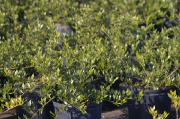 |
Gardenia jasmenoides 'Radicans' | Gardenia 'Radicans' |
s/sh
|
A
dwarf spreading variety with mid-sized blooms. Z-7; H-2'; sun; dry; evergreen; white, fragrant flowers |
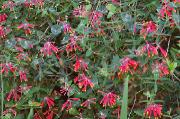 |
Lonicera sempervirens | Honeysuckle, Coral |
s/sh
|
NBH
This native woody vine is a fast growing favorite of butterflies and
Hummingbirds. It seeks the sun and likes well drained areas. While
it doesn't have the fragrance of "Japanese Honeysuckle",
it is not invasive and it has coral flowers instead of the dull beige
flowers of its oriental cousin. Peak blooms in mid-spring; some flowers
nearly all year. Evergreen on the gulf coast. It can be used on fences
and makes a nice cover for an arbor. Z-6; vine; s/sh; dry; evergreen; red flowers |
| Leucothoe racemosa | Leucothoe |
s/sh
|
I
was told there is a new species name for this plant (Eubotrys racemosa)
but I'm tired of learning new names and they aren't on my spell-checker.
This short, deciduous shrub has long racemes of white flowers in the
spring and the seed pods persist into the fall. It has nice fall color
and is found in nature near bottom land but not in the really wet
areas. The form we have came from Nell Kieff over near Van Cleve,
MS in the Pascagoula River swamp. (She's collected many good forms
of the plants near her home.) This shrub can get to 3 feet tall and
is wider than tall. Z-7; H-4'; s/sh; moist; white flowers |
|
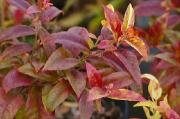 |
Leucothoe axillaris 'Dodd's Variegated' | Leucothoe, 'Dodd's Variegated' |
s/sh
|
N Over many years, we would sometimes find a variegated form of L. axillaris in our seedlings while trying to find a form that was not so prone to root problems. We saved the variegated forms and decided to select one that was the best one to grow. We quit using fungicides on them and watched while all but three died over the years. We selected the best and named it. It makes an excellent low shrub for shady, well drained areas and seems to do much better in the ground than in a container in our nursery. The new foliage in the spring is pink and then it becomes variegated over the summer. In the fall it will change colors slightly. It is a great plant for many seasons in the garden. |
| Leucothoe axillaris 'Jenkins' | Leucothoe, Fetter Bush or Dog Hobble |
s/sh
|
N There are many common names for L. axillaris, among them "Dog Hobble", "Fetter Bush", and many others. L. axillaris 'Jenkins' was found down in Florida by David Drylie and given to "Miss Margie" Jenkins in Amite, La. I got the plant from her and asked about a name and she said to call it "Florida Leucothoe". We couldn't do that as that is the common name for Agarista populifolia. So I named it for the neatest lady in Horticulture. It has wider leaves than normal for the species, is dark green, grows very well in the south, and makes an excellent low shrub for a shady, well drained area. It has a lot less trouble with root problems than other members of the species and grows better than any other evergreen Leucothoe we've tried. | |
| Rhododendron x 'Stonewall Jackson' | Rhododendron x 'Stonewall Jackson' |
s/sh
|
N Medium orange. The largest of the series. My favorite native azalea and my favorite general. | |
| Rhododendron 'Madison' |
Rhododendron 'Madison' |
s/sh
|
N Exbury; Z-6; H-10'; s/sh; dry; orange flowers | |
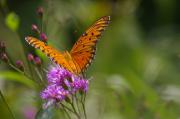 |
Stokesia laevis | Stoke's aster |
s/sh
|
NB
One
of our best known native perennials. We grow a blue flowered form
and a pure white flowered form. Evergreen leaves. Sun or shade. Moist
or average soil. Have seen these growing wild along the roadside in
South Mississippi. H-6in; s/sh; wet/dry; evergreen; blue flower |
| Stokesia laevis - white flower | Stokesia laevis - white flower |
s/sh
|
N
see
above H-6in; s/sh; wet/dry; evergreen; white flower |
|
| Azalea x Poukenense | Azalea, Korean |
s/sh
|
The
Korean Azalea. Very hardy. Species has purple flowers but we have
some seedlings with other colors that will be produced soon. Down
south they are evergreen but not at the top of their range. Medium
to large, midseason. Z-5; H-5'; s/sh; dry; semi-evergreen |
|
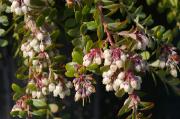 |
Vaccinium darrowii | Blueberry, Darrow |
s/sh
|
N
A
great landscape plant for a dry area that may be hard to establish,
but well worth the effort. It has grey-green foliage, (bronze foliage
in the winter) and it does produce fruit, albeit small. I once told
a customer that we only sold those plants to people with short children
or bird lovers because it was too much trouble to bend down long enough
to get a snack. It seems to like the sun or part shade and must have
good drainage. Several selections are available, but we like the diversity
in the species. H-2'; s/sh; dry; evergreen; white flower |
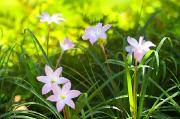 |
Zephranthes grandiflora | Pink Rain Lily |
s/sh
|
N
Fun
to plant in masses and wait for it to bloom. Fun to sell at plant
sales because it is never in bloom and you are basically convincing
someone to buy a pot of dirt. This is the kind of plant you will find
at arboreta and Master Gardener sales, because most retailers aren't
willing to risk it. H-6in; s/sh; dry; pink flower |
| Agarista populifolia (Leucothoe) | Leucothoe, Florida |
s/sh
|
N Probably my favorite shrub/small tree, this plant likes a shady spot with good drainage. It has long arching limbs and fragrant, small bell-shaped flowers in the spring that smell like raw honey. The cut foliage is long-lasting for flower arrangements. It makes a nice screen or an attractive specimen. Native range is from central Florida to coastal South Carolina but will thrive in Memphis, Birmingham, and Atlanta. The dwarf form, found by David Taylor, is called 'Leprechaun' and grows only about 1/3 the 25 foot height of the species but with all the other good characteristics. | |
| Aucuba
japonica green |
Aucuba, Green | The non-variegated female forms are more attractive than the variegated female forms to me because I don't like red and yellow together (sorta like the colors on Coral Snakes). This plant must be planted in the shade in a well drained site. | ||
| Aspidistra
elatior variegated sp. |
Cast
Iron Plant, Variegated |
sh
|
||
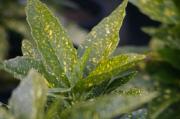 |
Aucuba
japonica variegated |
Aucuba, Variegated |
sh
|
This dioecious plant is most often seen in Garden centers as a variegated plant called "Gold Dust Aucuba" The female forms have beautiful red berries in the Winter. |
| Aspidistra elatior 'Milky Way' | Cast
Iron Plant, Dwarf Variegated |
sh
|
This oriental native loves the deep shade of the South. The form normally seen has leaves about 18 to 24 inches long. There are various cultivars including a variegated form and a dwarf variegated form that my father introduced from Japan in the 1970's named 'Milky Way'. I was told that the common name came from the fact that it is almost impossible for a novice gardener to kill it. A popular indoor plant in nineteenth century England; Sherlock Holmes grew a potted specimen at his famous 221-B Baker St. residence. | |
| Gordonia
lasianthus |
Loblolly Bay |
sh/part
|
N
A member of the Camellia family, this tree is known for the white
blooms it produces during the entire summer. It likes some protection
from afternoon sun but will tolerate full sun if taken care of while
getting established. The largest we have seen were on the banks of
the canal in the Okefenokee Swamp. It is rather rare in the wild but
is usually found near, but not in, wetlands. It is native from coastal
North Carolina to Florida and Mississippi. Rather slow-growing well
formed evergreen tree hardy south of Atlanta. Gets good red fall color. Z-7 or 8; H-30'; sh/part; dry; evergreen; white |
|
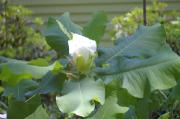 |
Magnolia macrophylla | Magnolia, Big-Leaf |
N
This
is a very good tree. It likes to grow in shady areas and can get very
tall. It is deciduous and has large, white blooms in the spring. I
like this tree so much that I named a favorite Basset Hound "Canis
macrophylla" (called "Mac" for short) There is a picture
in Dr. Roland Harper's book on the flora of Alabama that shows a man
holding a branch with leaves almost as long as he was tall and the
flower in that picture appeared to be 18 inches wide. I doubt that
many of the trees we see today would be as large but we can always
hope to see one like that someday. H-30'; s/sh; dry; white flowers |
|
| Magnolia asheii | Magnolia, Ashe's |
sh/sun
|
N
This
form of M. macrophylla is smaller but will have beautiful, large white
blooms at a very early age. It is better suited for a small garden
than M. macrophylla and the seed pods in late summer are beautiful.
It is found in a few spots in the Florida panhandle and has been reported
west of there, but I haven't seen it. It is deciduous and can grow
well as far north as Indiana. It has leaves almost as large as the
M. macrophylla and the flowers are more fragrant to me. H-20'; sh/sun; dry; white, fragrant flower |
|
| Lyonia ferruginea | Lyonia, Rusty |
sh/sun
|
N
This
small, evergreen tree, native of the Florida Panhandle and adjacent
areas, is found in shady low places. It has beautiful twisted, cinnamon
colored trunks and the new leaves in the spring are rusty colored.
It is slow to grow but well worth the wait. Z-7; H-6'; sh/sun; dry; evergreen |
|
| Cyrtomium
falcatum 'Rochfordianum' |
Fern, Holly | Evergreen
fern found commonly in gardens. When we first thought about growing
a few ferns, we thought this would be an easy one to grow. Not so.
It fusses and looks horrible in a nursery container, like many of
the ferns. We'll probably try royal and cinnamon in the future as
we tend to over water some of the others. Z-7; H-2'; shade; dry; evergreen |
||
| Dryopteris
erythrosora 'Brilliance' |
Fern, Autumn |
shade
|
Rusty
fall color. Shade and dry. Z-6; H-2'; shade; dry; evergreen |
|
| Rhodea japonica | Sacred
Lily or Nippon Lily |
shade
|
H-2'; shade; dry; evergreen | |
| Rhaphidyphyllum hystrix | Palm, Needle |
shade
|
This rare shrub-palm is the hardiest of all our native palms, "Needle Palm" ranges as far north as Auburn, AL It slowly grows in shady areas and the common name comes from the crop of needles that protect the trunk from predators. The largest we have seen is down near Orange Beach, AL and it is probably several hundred years old. It has a large, palmate green leaf and there are male and female plants. | |
.jpg) |
Pinckneya
bracteata (syn. P. pubens) |
Georgia Fever Tree |
shade
|
N
A
large, deciduous shrub found in only a few moist, sunny places now.
The common name comes from the fact that the bark was made into a
tea to eliminate the symptoms of malaria during "the recent unpleasantness"
when the southern troops were unable to get Quinine due to the blockade
by the damnyankees. There were many more plants then in the south
but taking the bark off of many of them killed most and we have only
a few surviving populations left. The large pink bracts in the summer
give it its species name and they are very attractive. It can be hard
to establish. Get 3 and maybe one will survive. It is a show stopper
if it likes you. "Blooms" like a pink poinsettia in May. Z-7; H-6'; shade; moist; pink flower |
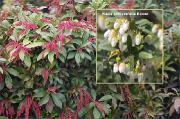 |
Pieris
x japonica- general |
Pieris or Andromeda |
shade
|
Dad planted some seeds of Pieris japonica that had probably crossed with P. tiawanensis and gave some of the seedlings to my uncle who planted them in his garden. Later, the uncle decided he didn't like the plants so cuttings were taken of the survivors (Darwin testing) and the various ones were grown and given names of waterfalls. Some of the ones we grow are 'Bridal Vail Falls', Crystal Cascade Falls', 'Shining Cloud Falls', and 'Sugar Run Falls'. These all will get to about 6 feet tall, are evergreen and bloom in March in Mobile. Usually we don't suggest this plant for the deep south as it typically doesn't like our hot, summer nights, but these seem to do well in a shady, well drained location and give special interest when the long bloom spikes give the appearance of the spray and foam of a beautiful waterfall. |
| Pieris
x japonica 'Dodd's Sugar Run Falls' |
Pieris 'Dodd's Sugar Run Falls' |
shade
|
see
above Z-6; H-6'; shade; dry; evergreen; white flowers |
|
| Pieris
x japonica 'Dodd's Shining Cloud Falls' |
Pieris 'Dodd's Shining Cloud Falls' |
shade
|
see
above Z-6; H-6'; shade; dry; evergreen; white flowers |
|
| Pieris
x japonica 'Dodd's Pearl Falls' |
Pieris 'Dodd's Pearl Falls' |
shade
|
see
above Z-6; H-6'; shade; dry; evergreen; white flowers |
|
|
Pieris x japonica 'Dodd's Crystal Cascade Falls' |
Pieris 'Dodd's Crystal Cascade Falls' |
shade
|
see
above Z-6; H-6'; shade; dry; evergreen; white flowers |
|
| Pieris
x japonica 'Dodd's Bridal Veil Falls' |
Pieris
'Dodd's Bridal Veil Falls' |
shade
|
see
above Z-6; H-6'; shade; dry; evergreen; white flowers |
|
| Pieris
phillyreifolia 'Baldwin' |
Pieris, Swamp Native |
shade
|
Thayer
spotted this plant in the Bon Secure State Park in Baldwin County,
Al. We had never considered looking for it in an area near the Gulf
that had Sand Pines, Ilex cassine, Sand Live Oaks, etc. so we all
were surprised to find it there. In all the books we had read, this
plant was supposed to be in the swamp. Here it was as a beautiful
ground cover in the wrong place. Evidently, it didn't read the same
books. It took us a few minutes to realize what the plant was, but
after eliminating all the others we could think of or find in our
textbooks and then later seeing it bloom after taking cuttings and
growing it at the nursery, we were sure what it was. We later found
it along Fowl River in Mobile county, right where it had been reported
50 years earlier, but not in the habitat we had assumed it would be
found. It blooms in early February and loves a shady, well drained
site and will cover an area slowly. It is evergreen with slightly
larger leaves and flowers than the species. Z-7; H-2'; shade; dry; evergreen; white flower |
|
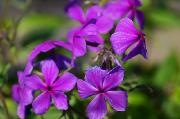 |
Phlox divaricata | Phlox, Wild Blue or Phlox, Woodland |
shade
|
N Early spring blue blooms on this shade loving evergreen groundcover. |
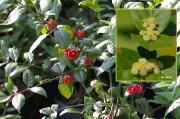 |
Euonymus americana | Hearts-A-Burstin' |
shade
|
N New York south to Florida and Texas. Deciduous shrub to about 5' tall; interesting 5-petaled white flowers in late spring. In September, the raspberry colored pods open and red seeds hang out. Found in shady woods not too far from water. The seed are loved by turkeys and the leaves and stems are grazed by rabbits and deer. |
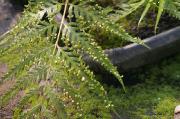 |
Woodwardia orientalis | Fern, Oriental Mother |
shade
|
My first plant came from Katie Ferguson in Texas. She told me to try it and I had no idea that it would get so large and beautiful. It can have fronds as long as three feet and is evergreen. It likes filtered shade and some moisture and it gets its common name from the tiny "fernlets" that form on top of the fronds and then drop to the ground to grow. |
| Fatsia japonica | Fatsia |
shade
|
This
evergreen, shade loving plant from Japan is a favorite for southern
gardens. The large green leaves provide a wonderful texture and it
is easy to establish. Z-8; H-3'; shade; dry; evergreen |
|
| Fothergilla x gardenii 'Mt. Airy' | Fothergilla
'Mt. Airy' |
shade
|
N
A member of the witch hazel family, this plant was popularized by
Dr. Dirr in Georgia. The species ranges from Virginia to the Gulf
Coast and has wonderful fall color. It likes shade and average to
dry conditions. Z-6; H-3'; shade; dry; white fragrant flowers; great Fall color |
|
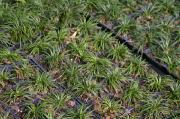 |
Ophiopogon japonicus - dwarf | Mondo
Grass, Dwarf |
shade
|
This
is a good, short groundcover (5 or 6 inches tall) and likes shady
areas. It will spread and fill an area in a short time and is another
evergreen member of the lily family from Japan. H-6"; shade; dry; evergreen; lavender flowers |
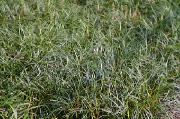 |
Ophiopogon japonicus | Mondo Grass |
shade
|
This is a good, short groundcover (5 or 6 inches tall) and likes shady areas. It will spread and fill an area in a short time and is another evergreen member of the lily family from Japan. |
| Mahonia bealii | Oregon Grape Holly |
shade
|
This shade-loving plant is not related to hollies or grapes at all but the leaves have soft spines that resemble a holly and the fruit in the fall looks like clusters of grapes. The yellow spring blooms are showy and the plant adds interest wherever it is used. | |
| Rhododendron serrulatum | Swamp Azalea |
shade
|
N
This
is a white flowered form that is found near, but not in, swamps. Different
populations of this plant bloom at different times. Near our home,
we have groups that bloom in June, some groups in July, a few groups
in August, and one group blooms around Labor Day. It is fragrant and
grows well in some shade but it doesn't like wet feet. (See Rhododendron
oblongifolium) We find this to be one of the easiest to grow. H-8'; sh/sun; dry/moist; white flowers |
|
| Chamaecyparis obtusa 'Fern Spray' | Hinoki cypress 'Fern Spray' |
shade
|
A
very fine cultivar with fine textured foliage that can grow to large
size. This native of Japan is a favorite there and honored as any
great tree should be. Z-5; H-30'; shade; dry; evergreen |
|
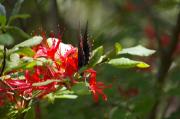 |
Rhododendron prunifolium | Plum-Leaf Azalea |
shade
|
N This native azalea has beautiful orange to red flowers in the Summer. Even though it is not fragrant, having such beautiful flowers in the summer makes up for that one shortcoming. It was originally found near Pine Mountain, Georgia but it also occurs in adjacent Alabama. It is must have shade and good drainage to do well. There is a beautiful 30 year old plant at home that blooms pink in July-August. It must be a hybrid of R. arborescens. Some of the seed from this plant have grown very well and we offer them as R. x prunifolium. |
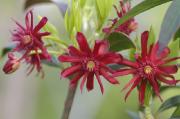 |
Illicium floridanum | Anise, Florida |
shade
|
N
This large, evergreen shrub loves shade. It is found in swamps (but
not in the really wet areas)in the southern U.S. It has crimson flowers
in the summer and the leaves have an odor like the herb anise. It
makes a great screen in the shade and the foliage is a rich dark green.
(A similar form, Illicium mexicanum, is shorter and much harder to
grow and ship because its limbs are so brittle.) "Florida Anise"
is found from La. To Fl. and on up into S.C. It is the hardiest of
all the Illiciums and can grow up into Pa. Z-5; H-10'; shade; moist;evergreen; maroon flowers |
| Illicium floridanum 'Pebblebrook' | Anise,
Florida 'Pebblebrook' |
shade
|
N
Z-5; H-6'; shade; moist;evergreen; maroon flowers |
|
| Illicium floridanum 'Semmes' | Anise,
Florida 'Semmes' |
shade
|
N
This variety differs from the species in that it has white flowers
and will take a little bit more sun. Except for the flowers, it is
very much like the species, Illicium floridanum. Z-5; H-5'; shade; dry; evergreen; white flowers |
|
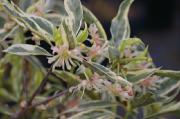 |
Illicium
floridanum 'Shady Lady' PP |
Anise,
Florida 'Shady Lady' PP |
shade
|
N
We found this variegated variety as a sport on I. floridanum 'Semmes'
in 1989 while we were living in Charleston. We propagated two plants
from the sport (we still have one) and determined it likes the same
conditions as the parent. The original plant is now 6 feet tall and
4 feet wide and is still producing pink flowers. I think it will get
much larger, given enough time. (I have to confess that I told a lie
to a very difficult retail customer late one good sailing day when
I told her it was an aphrodisiac and hallucenogenic. I hope she didn't
try it.) Z-5; H-5'; shade; dry;evergreen; pink flowers |
| Lyonia eliptica | Lyonia, Oriental |
shade
|
Z-6; H6'; shade; dry; white flowers | |
| Selaginella uncinata 'Peacock' | Spikemoss 'Peacock' |
shade
|
||
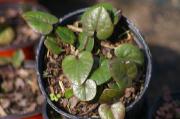 |
Hexastylus x Harperii | Native Ginger |
shade
|
N
Native groundcover ginger. Heart shaped leaves with a "little
brown jug" flower. Dry shade. Z-7; H-1in; shade; dry; evergreen; flower-brown jug |
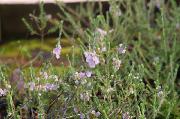 |
Kalmia hirsuta | Hairy Wicky or Beach Laurel |
shade
|
N
This relative of "Mountain Laurel" is found in shady, well
drained areas in the southeast. It is a small, (2 feet) plant with
very small leaves and flowers like (but smaller) than the "Mountain
Laurel". The small leaves are "hairy" and are not as
dark as its cousins but it is a very neat plant for a small area with
a lot of year round interest. Z-8; H-1'; shade; dry;evergreen; pink flower |
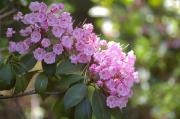 |
Kalmia latifolia | Mountain
laurel - southern form |
shade
|
N
This
species ranges from Maine to Mobile. It is a shade loving plant that
is a favorite of many. I have tried growing many of the forms that
Dr. Dick Jaynes has introduced but have had poor luck. This plant
doesn't move south very well, sorta like "Dogwoods" and
women. We collect seeds from the very southern end of the range and
have good luck growing them and they will do well all the way up to
the mountains. Most of them have medium pink flowers but sometimes
we get a darker or lighter flower on some of them. When we plant the
seed, it takes two years to get big enough to put into a 3 ½
inch pot. Then it spends a year there before going into a 1 gallon
pot. Two years later we plant it in a three gallon and sell it a year
or so later. Finally it starts growing fast enough that we can sell
them to use in a landscape. I have some here at the house that are
about 12 to 15 feet tall, 10 feet wide and with beautiful, thick foliage
and wonderful twisted trunks and limbs. Z-7; H-15'; shade; dry;evergreen; pink flowers |
| Liriope
muscari 'Munroe's White' |
Liriope 'Munroe's White' |
shade
|
This
Liriope differs from L. muscari 'Big Blue' in that it has white flowers
and prefers shade. Also used in shade borders and mass plantings. Z-6; H-12"; shade; dry; evergreen; white flowers |
|
| Satureja georgiana | Winter savory |
shade
|
N Z-6; H-6"; shade; dry; evergreen; blue flower |
|
| Hosta
sp |
Hosta |
shade
|
Z-6; H-6"; shade; dry; lavender flowers | |
| Liriope 'Lynn Lowrey' | Liriope 'Lynn Lowrey' | Sometimes called "Giant Liriope", it isn't a Liriope at all. See Ophiopogon 'Lynn Lowery' | ||
| Lantana depressa | Pineland Lantana |
sun
|
N
A rare southeastern native with pale yellow flowers. A good groundcover
for sunny, well-drained locations. Cold hardy in Gulf Breeze, FL and
probably in Mobile. Z-8 ; H-2'; sun; dry; evergreen?; yellow flowers |
|
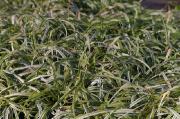 |
Liriope muscari 'Variegated' | Liriope
'Variegated' |
sun
|
A
variegated form of L. muscari, it also is used in sunny borders and
mass plantings. Z-6; H-6"; sun; dry; evergreen; purple flowers |
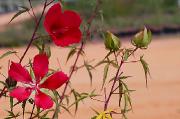 |
Hibiscus coccinea | Hibiscus,
Scarlet Rosemallow or Texas Star |
sun
|
NB
Bright
red deep cut star shaped flowers with deep cut five lobe leaves that
have been mistaken by Florida agriculture inspectors. Z-8; H-5'; sun; wet/dry; red flower |
|
Hibiscus
- |
Hibiscus |
sun
|
NB Members of the mallow family are cousins of cotton. The native hibiscus are normally found in wet sunny areas along the Gulf Coast and are cold hardy in zone 8 and probably 7. They die back to canes in the winter, which should be cut off before they start growing in the spring. They attract a wide variety of bugs and butterflies. Can grow 5-8' in one season. As the plant ages and produces more stalks, it gets bigger each year. Do well in average but not dry soils. | |
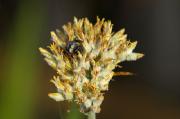 |
Lacnanthes caroliana | Carolina Redroot |
sun
|
N
Another neat bog plant. H-1'; sun; wet/dry; creamy flowers |
| Juniperus
virginiana 'Grey Owl' |
Juniper
|
sun
|
This 8' form of "Red Cedar" is a spreading, wider than tall
plant with grey foliage. It is a striking juniper and is tolerant
of sun and Yankees, but not wet areas. It will not deter Basset Hounds
as they can run under the lower limbs but it will stop short children.
It has good cut foliage for Christmas and the soft juniper fragrance
is pleasant in the home. Z-5; H-6'; sun; dry; evergreen |
|
| Verbena x 'Carolina Pink' | Verbena
'Carolina Pink' |
sun
|
NB
A
good selection of groundcover verbena. Butterflies love the blooms
all summer and into fall. Z-7; H-6"; sun; dry; evergreen; pink flower |
|
| Juniperus
horizontalis Procumbens nana |
Juniper
Procumbens nana |
sun
|
Z-6; H-1'; sun; dry; evergreen | |
| Illicium parviflorum |
Anise,
Yellow or |
sun
|
N
Dad first started growing this plant from cuttings we collected in
Ocala National Forrest in Florida. It had been mistakenly called "Japanese
Anise" by many because of a mistake in nomenclature by Fruitland
Nurseries in Augusta in the late 1800's. It is the perfect screen
for a sunny area and will get about 15 feet tall and 10 to 15 feet
wide in just a few years with proper care. The evergreen leaves are
not as dark green as I. floridanum (hence the name "Yellow Anise")
and the flowers are beige in color. Z-7; H-10' +; sun; dry; evergreen; yellow flowers |
|
| Ilex
x latifolia 'Miss Patricia' |
Holly,
Lustreleaf 'Miss Patricia' |
sun
|
This
is a selection of David Taylor of a dwarf form of 'Mary Nell'. His
named it for his wife and it has all the good characteristics of I.
x latifolia 'Mary Nell' but only grows 1/3 the height and has smaller
leaves. The leaves appear "sticky" but are soft to the touch.
Both of these hollies make fantastic Christmas foliage. Z-6; H-10'; sun; dry; evergreen; berries |
|
| Ilex
x latifolia 'Mary Nell' |
Holly,
Lustreleaf 'Mary Nell' |
sun
|
This
hybrid came about when Dad and Joe McDaniels were in the old stock
block looking at some different plants and they came upon I. CB-10,
a cross made by Mr. Hohlman of New Jersey. He made the cross trying
to get a holly that looked like I. cornuta 'Burfordii' but would be
hardy in the north. Unfortunately, the result was not as green nor
did it have as many berries so it didn't do too well in the market.
Dad and Joe found some I. latifolia pollen and dusted it on the CB-10
flowers and the result was one of the most beautiful hollies we've
ever seen. We named it after Joe's wife, Mary Nell McDaniels. The
original plant, 40 years old now, is about 30 feet tall. It is one
of the few hollies that will still produce berries in a lot of shade. Z-6; H-20'; sun; dry; evergreen; berries |
|
| Magnolia
stellata 'Pink Stardust' |
Magnolia,
'Pink Stardust' |
sun
|
This pink flowered form of "Star Magnolia" was selected from some seedlings Dad planted and he and Uncle Bill named it. It is deciduous and only gets about 10 to 15 feet tall. It likes the sun and a well drained spot and will give many years of beautiful, pink, early spring flowers. | |
| Gaura
lindheimerii |
Gaura
or Bee Blossom |
sun
|
N
'Whirling butterflies' and 'Siskiyou pink' are popular cultivars of
this popular perennial. It moves gracefully in a breeze and is a nice
filler for any garden. Z-7; H-3'; sun; dry |
|
| Ilex
x latifolia 'Bobby Dodd' |
Holly,
Lustreleaf 'Bobby Dodd' |
sun
|
N
My brother, Bobby, collected some seed from a female I. latifolia
growing at the greenhouse at Auburn University during his time as
a civil engineering student from 1964 to 1968. Dad planted the seed
and all of them looked much the same. We determined that the papa
was probably I. cornuta. Dad propagated many of the females (it took
awhile as seedlings are slow to get to maturity) and they were named,
as a group, the "Auburn Hollies". One of them, #119, was
planted at my house and it grew into a beautiful pyramidal, dark green
large shrub with heavy, large red berries. After Bobby passed away,
I just had to name this plant for him. I, and others of good plant
taste, think it is better looking than 'Nellie R. Stevens' and other
similar forms. Z-7; H-25'; sun; dry; evergreen; berries |
|
| Michella figo skinneriana | Banana Shrub |
sun
|
This
evergreen native of the orient is a small tree with flowers that resemble
a small banana and also have a wonderful banana-like fragrance. It
can handle some shade or sun and has been a favorite of southern gardens
for many years. Mom tells me that when she was a little girl, ladies
would pick the flowers and put them in a sachet. The plant needs to
be replaced every 50 or 60 years as it is not as long-lived as other
members of the Magnolia family. Z-8; H-30'; sun; dry;evergreen; creamy, fragrant flowers |
|
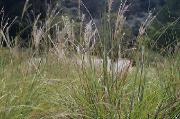 |
Miscanthus sinensis 'Adagio' | Grass, Maiden grass 'Adagio' |
sun
|
Short
form of Maiden grass. Ornamental clumping grass. H-3'; sun; dry; white inflorescenses |
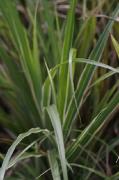 |
Miscanthus sinensis 'Cosmopolitan' | Grass, Maiden grass 'Cosmopolitan' |
sun
|
Tall,
vertically striped ornamental grass. H-8'; sun; dry; white inflorescenses |
| Miscanthus sinensis 'Gracillimus' | Grass, Maiden grass 'Gracillimus' |
sun
|
H-5'; sun; dry; white inflorescenses | |
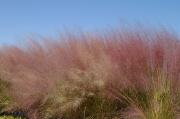 |
Muhlenbergia capillaris | Grass, Muhly |
sun
|
N H-3'; sun; dry; pink infloresences |
|
Myrica cerifera (syn. Morella cerifera) 'Salty Dog' |
Wax
Myrtle, 'Salty Dog' |
sun
|
N
David
and Patty Taylor selected this form down near the Gulf in Alabama.
It is a male form that grows a bit more dense than the species and
seems to tolerate salt better than most. It has an upright form and
grows almost anywhere there is sun. H-20'; sun; wet/dry; evergreen |
|
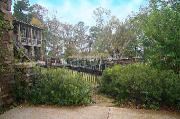 |
Myrica
cerifera (syn. Morella cerifera)'Tom's Dwarf' |
Wax
Myrtle, 'Tom's Dwarf' |
sun
|
N
During
the 1980's, Lynn Lowery from Texas sent Dad many Myrica cerifera seeds
he collected in various parts of LA and TX. We planted the seeds and
got many different forms. When we were in Charleston, I came down
to visit and while Dad and I were riding around the nursery, I noticed
that they had propagated several of the forms they had gotten from
Lynn. There were a few dwarf forms and I noticed that one of them
had no leaf spot, even with overhead irrigation. I asked David Taylor
why his crew hadn't sprayed one of the groups. He said none of them
had been sprayed. Therefore I immediately purchased all of that form,
named it 'Tom's Dwarf', and multiplied those plants. It is a true
dwarf in size and one of the easiest "Dwarf Wax Myrtles"
to grow. There are several dwarf forms in the trade but we like this
one best. H-3'; sun; wet/dry; evergreen |
| Myrica
cerifera (syn. Morella cerifera)'Wolf Bay' |
Wax
Myrtle, 'Wolf Bay' |
sun
|
N
Another
of David and Patty Taylor selections, this form is female with the
typical grey berries in the fall. It is more upright and thick than
the species and can tolerate salt better than most. It will grow anywhere
there is some sun. H-20'; sun; wet/dry; evergreen |
|
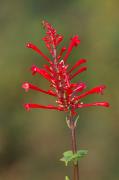 |
Odontonema stricta | Cardinal Spear |
sun
|
H Excellent perennial for hummingbirds. Red spikes of tubular flowers and dark green leaves prefer shady places. Reliable perennial in zone 8, but worth trying as an annual farther north. |
| Ilex
x attenuata 'Nasa' |
Holly, 'NASA' |
sun
|
N
This is a dwarf form of I. x attenuata (a naturally occurring hybrid
of I. cassine and I. opaca.) is male, has small leaves and is dark
green. It will, in time, get to about 4 or 5 feet tall and 3 or 4
feet wide. It was found by Dad on the NASA site in south Mississippi.
It is very slow growing so not many nurseries want to fool with it
but we think it has a special place in the landscape. Z-7; H-6'; sun; dry; evergreen; red berries |
|
| Ilex
x attenuata 'Bienville Gold' |
Holly,
'Bienville Gold' |
sun
|
N
This large, pyramidal form of I x attenuata ( a naturally occurring
hybrid of Ilex cassine and I. opaca) has beautiful gold berries. In
the early '80's Dad and I sent some 'Foster' hollies to a customer
in King of Prussia, Pa. so they would get pollinated by some northern
forms of I. opaca. We were trying to develop some forms that would
be more cold hardy than 'Foster'. When the berries were ripe, we had
our customer send us the seed and we planted them. (The plants we
sent didn't make it thru the winter there.) We found that we hadn't
gotten any more cold hardiness but one of the plants had larger yellow
fruit and grew very well in the south. It will get to at least 30
feet tall in time and is able to keep its berries on until the spring
because most birds don't recognize the yellow fruit as edible. The
best looking 'Bienville Gold' I have seen was planted in front of
a red brick wall and it was beautiful. Z-5; H-20'; sun; dry; evergreen; berries |
|
| Ophiopogon x 'Lynn Lowery' | Liriope,
'Lynn Lowery' Evergreen Giant |
sun
|
This is a good, short groundcover (5 or 6 inches tall) and likes shady areas. It will spread and fill an area in a short time and is another evergreen member of the lily family from Japan. | |
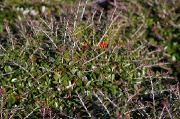 |
Ilex
vomatoria 'Taylor's Rudolf' |
Holly,
Yaupon 'Taylor's Rudolf' |
sun
|
N
A female, dwarf form with dark green leaves and lots of red berries.
It was selected by David Taylor from some of Dad's 'Gray's Greenleaf'
seedlings and I consider it the best of all the dwarf 'Yaupon"
forms. Z-7; H-3'; sun; dry; evergreen |
| Ilex
vomitoria 'Stoke's Dwarf' |
Holly,
Yaupon 'Stoke's Dwarf' |
sun
|
N
A dwarf form and is probably to most common type of "Yaupon"
found in the trade. Mr. Stokes in Louisiana found this plant and gave
one to Dad. He introduced it to the trade in the late '40's. About
that time, another nurseryman started growing a plant he called 'Schilliings'
that he got from Mr. Schillings. What Mr. Schillings didn't tell the
man was that he got the plant from Mr. Stokes and it was the same
plant. Since the two nurseries shipped to different customers in the
southeast, the plant got two different names in the trade. 'Stokes
Dwarf' is the proper name for this variety and 'Schillings' is an
illegitimate name according to our late friend Dr. Ted Dudley. Z-7; H-3'; sun; dry; evergreen |
|
| Ilex
vomitoria 'Oscar Gray' |
Holly,
Yaupon 'Oscar Gray' |
sun
|
N
A male, dwarf form with darker leaves. The original plant, a seedling
from 'Grays Greenleaf', is in Dad's yard and is the perfect, round,
dwarf form that many prefer for landscaping. Z-7; H-3'; sun; dry; evergreen |
|
| Panicum
virgatum 'Heavy Metal' |
Grass,
Switch |
sun
|
Native clumping ornamental grass. This one selected for color. | |
| Ilex
vomitoria 'Lynn Lowery' |
Holly,
Yaupon 'Lynn Lowery' |
sun
|
N
This form was sent to Dad by his friend in Texas, Lynn Lowery. Lynn
was one of the best plantsmen we ever met and I was fortunate to travel
with him to many places in the southeast, Texas, and Mexico looking
at plants. The leaves are larger than most forms and the fruit set
is perfect for Christmas. Z-7; H-10'; sun; dry;evergreen; berries |
|
| Ilex vomitoria 'Gray's Greenleaf' | Holly,
Yaupon 'Gray's Greenleaf' |
sun
|
N
This form was found in east Texas by Mr. Oscar Gray and has a tremendous
fruit set, darker green leaves, and is a bit slow growing for the
shrub forms of "Yaupon". Mr. Gray let Dad have some of these
plants (one type was a male with very tiny leaves, 'Gray's Littleleaf')
but 'Gray's Greenleaf' was so superior that Dad named it for Mr. Gray
and planted them at his house before he even started growing them
at the nursery. Unfortunately, numerous hurricanes have taken the
original plant out. Z-7; H-10'; sun; dry;evergreen; berries |
|
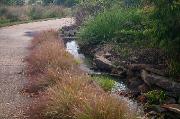 |
Eragrostis spectabilis | Grass, Purple love grass |
sun
|
N
Low growing, clumping native grass with pink fall panicles. Endless
possibilities as a ground cover or lining a bed or driveway. Z-7; H-2'; sun; dry; pink |
| Phlox pilosa | Phlox, Downy |
sun
|
N Spring pink blooms on short upright plants in full sun. Runs underground. | |
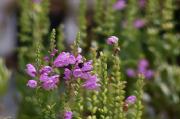 |
Physostegia virginiana | Obedient plant |
sun
|
N
Has
a reputation for not being obedient. Choose location carefully. Will
run in wet sun. 2-3ft lavender spikes bloom all summer. I used to
see them in ditches in south Mississippi. H-2'; sun; wet/dry; lavendar flower |
| Ilex vomitoria 'Fencerow' | Holly,
Yaupon 'Fencerow' |
sun
|
N
is an upright form, female, and is the only "normal" "yaupon"
we grow. It is typical of the species. We grow this one for folks
that are restoring a native area or are just trying to get a little
normalcy in their lives. |
|
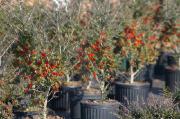 |
Ilex vomitoria 'Dodd's Cranberry' | Holly,
Yaupon 'Dodd's Cranberry' |
sun
|
N
is an upright, shrub form with numerous red beries. It is a seedling
from 'Gray's Greenleaf' (named by Dad) and has many of the same characteristics.
It's leaves are also darker green than other forms. Z-7; H-10'; sun; dry;evergreen; berries |
|
Ilex
vomatoria - |
Holly, Yaupon |
sun
|
N While Ilex crenata varieties do well in the upper South, the "Yaupon Hollies" do much better in the deep and middle South. They have almost no pests, will tolerate most of the soil types and conditions of the southern U.S., and there are numerous forms for many landscape uses. There are tall and narrow forms , weeping forms , shrub forms, small-leaf forms, large-leaf forms, dwarf forms, and forms with yellow berries instead of the normal red berries on the females of this species. Most know that the species name comes from the use by the Native Americans to "purge" the system after a big feast. A South American species, Ilex paraguanensis is still used by the locals to make a beverage, Yerbe Mate', that has more caffine than coffee. I suspect these two species had a common ancestor that produced caffine as a defense against some predator or just to keep somebody or something awake. (Thayer thinks that is the reason I like this species so much.) Although I have been unable to summon the nerve to try I. vomitoria tea, I have had Yerbe Mate (not as tasty as coffee) and it will "crank your tractor". (Three cups of that and you can thread a running sewing machine.) The birds in our area will consume "Yaupon" berries only after all the other holly berries had been eaten as "Yaupon" berries seem to give them a buzz. | |
| Ilex
opaca 'William Hawkins' |
Holly,
American, 'William Hawkins' |
sun
|
N
Dad found this form on a tree growing in Mr. Hawkins yard in Mentone,
Alabama. It was a male, dwarf sport with long spiny leaves. It is
a slow growing but neat plant. The largest plant I have seen was about
15 years old and 4 feet tall. Z_5; H-5'; sun; dry; evergreen |
|
| Ilex
cornuta 'China Girl' |
Holly, China Girl |
sun
|
Z-5; H-4'; sun; dry; evergreen | |
| Ilex
cornuta 'China Boy' |
Holly, China Boy |
sun
|
Z-5; H-4'; sun; dry; evergreen | |
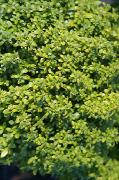 |
Ilex
crenata 'Soft Touch' |
Holly,
Soft Touch |
sun
|
Z-5; H-3'; sun; dry; evergreen |
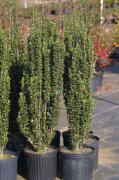 |
Ilex
crenata 'Sky Pencil' |
Holly,
Sky Pencil |
sun
|
Z-5; H-12'; sun; dry; evergreen |
| Podocarpus microphyllus 'Maki' | Japanese Yew |
sun
|
Podocarpus
macrophyllus is an old southern garden favorite, it is still used
as a "Corner Plant" or tall hedge in places and will live
to be a fairly large shrub/tree in time. The long, narrow evergreen
foliage is great for flower arrangements and the plant will grow in
many different soils, exposure, etc. The form we grow is P. microphyllus
'Maki'. When my oldest son was only 4 or 5 years old, he told his
grandfather the name of the plant as he passed it leaving the airport
on a Christmas visit, so you can imagine how good Santa Claus treated
him that particular year. Z-6; H-2'; sun; dry; evergreen |
|
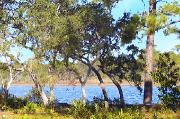 |
Quercus geminata | Oak, Sand Live |
sun
|
N
This
smaller, shrubby oak is found along the Gulf Coast in very dry, coastal
areas. It has the same form as the more common "Live Oak"
but is slower growing and more difficult to establish. We originally
thought that it grew slower because of its habitat, but growing it
in a nursery under the same conditions as other oaks demonstrated
that it didn't grow as fast, and it didn't like as much water as other
oaks. It has a beautiful shape and gives places like Grayton Beach,
Fl so much of the natural feel and beauty that demonstrate that the
coast is a pretty tough place to survive, if you're a plant. It is
a perfect little tree for the coast and almost looks like a tree cared
for by an artistic gardener when used in other settings. I have not
seen it growing right out on the beach, but it can be found back behind
the dunes. H-30'; sun; dry; evergreen |
| Quercus Michauxii | Oak,
Swamp Chestnut |
sun
|
N The common name for this tall, wide, specimen tree comes from the shape of the leaves and habitat. The leaves appear to resemble the leaf of the Chestnut tree and the trees are found in low places in the Southeast. It is deciduous and produces very large acorns that the deer prefer. It is a perfect shade tree and rather fast growing. | |
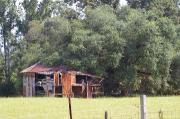 |
Quercus virginiana | Oak, Live |
sun
|
NB
This
is almost the "Holy Tree" in the deep south. It is a majestic,
wide growing evergreen tree. In colonial times, all of the species
belonged to the King for use only by the Royal Navy because of the
size, shape, and strength of the trunks and major limbs. It is the
best tree to withstand the hurricane winds (along with Cypress) because
the roots spread so widely. There have been millions of car and pickup
engines removed and repaired using this tree, a chain fall, profanity,
and lots of beer. Hence the origin of the term "Southern Shade
Tree Mechanic". H-40'; sun; dry; evergreen |
| Raphiolepis
indica 'Snow White' |
Indian Hawthorn, White |
sun
|
We grow the white form of this plant because the pink flowered forms don't perform as well down south. No need to describe this plant because everyone in the south has been to McDonalds and seen it there by the zillions. | |
| Raphiolepis umbellata 'minor' | Indian
Hawthorn, Dwarf |
sun
|
This is a dwarf form of the small blooming tree from the Indian Subcontinent and south Asia that lots of municipal landscape crews love to shape like giant popsicles. The 'minor' form is dwarf and lends itself best to low, dense hedges with some spring white flowers. When Dad brought it back from a nursery in Japan, he put the name 'minor' on it because no one could translate the tag from the Japanese nursery (not even a Japanese friend). | |
| Ilex crenata 'Hoogendorn' | Holly, Hoogendorn |
sun
|
Z-5; H-4'; sun; dry; evergreen | |
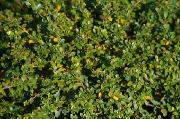 |
Ilex crenata 'Helleri' | Holly, Helleri |
sun
|
Z-5; H-3'; sun; dry; evergreen |
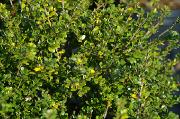 |
Ilex crenata 'Compacta' |
Holly, Compacta |
sun
|
Z-5; H-4'; sun; dry; evergreen |
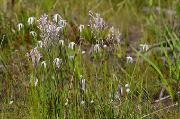 |
Dichromena
latifolia (syn. Rhynchospora latifolia) |
Sedge,
White topped |
sun
|
N
Bogs and wet areas are the source of some of the most beautiful
herbaceous plants. They will usually grow almost anywhere in a garden.
It's the old rule that you can move a plant up the slope but not
down. This one is striking massed or scattered with other perennials. |
|
Ilex
crenata - |
Holly, Japanese |
sun
|
There are uncountable varieties of this species but the ones in the trade are mostly dwarf, compact types. We have a few favorites, among them are 'Hellerii', 'Compacta', 'Hoogendorn', and 'Soft Touch'. There is also a tall, narrow form called 'Sky Pencil'. You can find descriptions of these hollies everywhere. They are described better by someone that likes them. | |
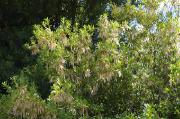 |
Cyrilla
racemiflora |
Titi or Leatherwood |
sun
|
NBB
Found in the coastal plains from Virginia to Texas. A neat wetlands
plant that will grow almost anywhere. Beautiful gnarly trunks, good
white blooms in early summer, good fall color on older leaves. Underused
plant of promise. Can be a great accent or incorporated in a screen.
It can be a large shrub or a single trunk tree. Attracts bees, butterflies,
and birds. Z-7; H-10-15'; sun; wet/dry; semi-evergreen; white flowers |
| Cyrilla
parviflora - 'Kristi' |
Titi, Small leaved |
sun
|
N
Thayer and Nell found this near Grayton Beach and named for Nell's
granddaughter who was with us on that trip. It is a small tree/large
shrub usually found in damp areas with early summer flowers and the
seed pods persist until fall when it gets some color on many of the
leaves. A finer textured version of C. racemosa. Z-7; H-6'; sun; wet/dry; semi-evergreen |
|
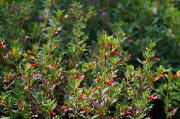 |
Cuphea ingea | Cigar Plant |
sun
|
BH Fun annual or sometimes perennial that butterflies and hummers love. Orange and pink forms. Full sun and good drainage. |
| Cryptomeria 'Yoshino' | Cryptomeria 'Yoshino' |
sun
|
||
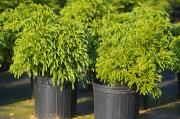 |
Cryptomeria 'Globosa nana' | Cryptomeria 'Globosa nana' |
sun
|
See
above. Z-5; H-4'; sh; dry; evergreen |
| Cryptomeria
- general |
Cryptomeria |
sun
|
Fast growing, pyramidal conifer. The entrance to the Bonsai collection at the National Arboretum in Washington, D.C. is through a small forest of these. Beautiful to behold. There are several cultivars, such as 'Yoshino' that are frequently planted. We grow 'Yoshino' and a dwarf, rounded form, 'Globosa Nana'. | |
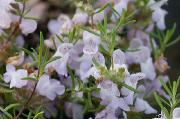 |
Conradina canescens | Rosemary, Beach |
sun
|
N
Found in sandy, coastal pinelands in Florida and south Alabama. Has
pale purple blooms on rosemary scented gray-green needle-like foliage
and will tolerate full sun if properly planted and cared for initially.
Do not overwater. Z-7; H-1'; sun; dry; evergreen; blue flowers |
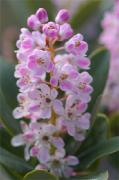
| Cliftonia monophylla 'Vancleave' | Titi, Black or Buckwheat Ree or Spring Titi |
sun
|
N
Found in swamps and rivers from Louisiana to North Florida and Georgia,
this great little evergreen tree is very showy when it blooms in the
spring. A favorite of honey bees and honey lovers. We found a striking
pink form in Van Cleave, Mississippi and introduced it to the trade,
naming it for the town as 'Van Cleave' Z-7; H-15'; sun; wet/dry; evergreen; pink flowers |
| Ilex
cassine 'Tensaw' |
Holly,
Dahoon, 'Tensaw' |
sun
|
N
We selected this form of I. cassine for her rounded habit, wide green
leaves, and red berries. It will make a very dense screen but doesn't
get as tall (12 to 15 feet) as most members of the species. This plant
needs a moist (but not wet) site and will fruit better in sun. Like
most I. cassine forms, It isn't hardy north of Atlanta but can tolerate
even south Florida. Z-7or 8; H-10'; sun; moist; evergreen; berries |
|
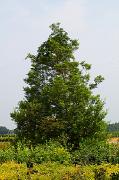 |
Ilex
cassine 'Perdido' |
Holly,
Dahoon, 'Perdido' |
sun
|
N
We selected this form of I. cassine for her tall, pyramidal habit,
long narrow leaves, and excellent red berries. It is not as dense
as I. cassine 'Tensaw' but makes a light screen for damp areas or
in dry sites with some irrigation. She likes sun and is a favorite
with birds in the winter when in full fruit. A very good plant for
the lower south and coastal areas. Z-7or 8; H-20'; sun; moist; evergreen; berries |
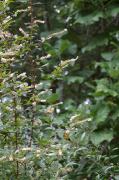 |
Clethra
alnifolia 'Sherry Sue' |
Sweet Pepper Bush 'Sherry Sue' |
sun
|
NB Z-5; H-6'; sun; wet/dry; pink flowers |
| Clethra
alnifolia 'Ruby Spice' |
Sweet Pepper Bush 'Ruby Spice' |
sun
|
NB
Z-5; H-4'; sun; wet/dry; pink flowers |
|
| Clethra
alnifolia general |
Sweet Pepper Bush |
sun
|
N Native from Maine to Florida in the coastal plain and Piedmont areas, this deciduous shrub is usually found in damp areas but will tolerate most soil types and conditions. They have fragrant flowers in the early summer, interesting seed pods (look like peppercorns) in the fall and winter, neat cinnamon bark and there are pink forms and white forms. 'Sherry Sue' was found by Thayer in Grayton Beach and has red twigs with white flowers. 'Ruby Spice' is a nice pink form. Unlike the late blooming form 'Hummingbird', they are much taller, up to 8 feet in some soils. | |
| Chrysopsis
graminifolia |
Silk Grass |
sun
|
N
Not a grass, but a member of the aster family. Fall yellow blooms
on strappy evergreen leaves with a silvery sheen. Great groundcover
for full sun and sandy soils. H-1'; sun; dry; evergreen; yellow |
|
| Chamaecyparis thyoides 'Henryae' | Southern White Cedar |
sun
|
Can
grow on dry sites if established with moderate moisture. It was the
preferred wood for boat builders and George Washington referred to
it as "Juniper" in his notes when he surveyed the Dismal
Swamp. We have seen beautiful specimens along many southern rivers. |
|
| Ilex cassine myrtifolia | Holly, Dahoon |
sun
|
N
This Southeastern native is a favorite of collectors because of the
small, evergreen leaves, the red fruit of the females, and the shape
of the plant itself. It lends itself to being a specimen and likes
moist sites and will grow in some light shade or sun. We spent years
arguing with Dr. Ted Dudley whether it is a separate species or a
variety of I. cassine and he said he was taxomically correct and I
was biologically correct????? This, and the fact that I don't like
grasses, and am not weird, is why I didn't become a botanist. Z-7; H-6'; sun; moist; evergreen; berries |
|
| Buddleia davidii 'White Profusion' | Butterfly
bush 'White Profusion' |
sun
|
B
white Z-5; H-5'; sun; dry |
|
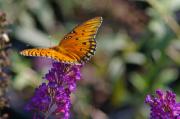 |
Buddleia davidii 'Royal Red' | Butterfly
bush 'Royal Red' |
sun
|
B
dark red Z-5; H-4'; sun; dry |
| Buddleia davidii 'Nanho Purple' | Butterfly
bush 'Nanho Purple' |
sun
|
B
lavender Z-5; H-4'; sun; dry |
|
| Buddleia davidii 'Dark Knight' | Butterfly
bush 'Dark Knight' |
sun
|
B
dark purple Z-5; H-4'; sun; dry |
|
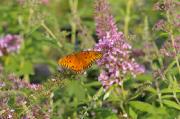 |
Buddleia davidii 'Charming Summer' | Butterfly
bush 'Charming Summer' |
sun
|
B
soft
pink Z-5; H-4'; sun; dry |
| Buddleia davidii |
Butterfly bush-general comments |
sun
|
B There are many cultivars of this Chinese native. Most will get 3 or 4 feet tall and as wide. Full Sun and good drainage. If deadheaded they will bloom from spring until freeze. They are a continuous supply of nectar for butterflies and hummingbirds. Below are some of the cultivars and their colors. | |
|
Hypericum
reductum |
Hypericum, Creeping beach |
sun
|
N
A very low, creeping form of H. reductum. We still can't understand
why this low plant from the Southeastern U.S. is named for a tall
mountain in Africa??? It is a beautiful ground cover when used in
mass and easy to grow in sun with good drainage. Z-6; H-1'; sun; dry; evergreeen; yellow flowers |
|
| Rosmarinus officianalis 'Cobalt' | Rosemary |
sun
|
This
herb, native to the southern European coastal areas, is used in cooking.
It is a fine landscape plant and has beautiful dark blue flowers in
the winter. It likes sun and good drainage. The form we grow is well
adapted for landscape use as well as for fragrance and flavor. There
are many more forms of this plant and many uses in the landscape and
kitchen. H-3'; sun; dry; evergreen; dark blue flower |
|
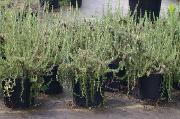 |
Rosmarinus
officianalis prostrata |
Rosemary, Creeping |
sun
|
We also grow 'prostrata' which is much lower and makes a beautiful
grey/green ground cover in the sun. H-2'; sun; dry; evergreen; lt blue flowers |
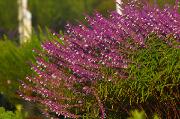 |
Salvia | Salvia |
sun
|
B Many forms of Salvia are available and what we have available depends on what Thayer likes this year. Two favorite reliable forms are 'Indigo Spires' and Salvia leucantha, Mexican bush sage. Google them. |
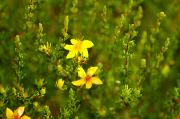 |
Hypericum reductum | Hypericum,
Beach |
sun
|
N
A small St. John's Wort that is normally found near the beaches in
the south. It likes full sun and good drainage and blooms with small,
yellow flowers in early summer. Even though St. John's Wort is supposed
to help with depression, when our Basset hounds consume it, they still
look depressed. (The herbal remedy comes from H. perforatum from England) Z-6; H-2'; sun; dry; evergreeen; yellow flowers |
| Viburnum
obovatum 'Mrs. Shiller's' |
Viburnum
obovatum 'Mrs. Shiller's' |
sun
|
N
We
love the native viburnums and hats off to Mike Dirr for writing about
them and trying to educate people about them. Seems that if it doesn't
have a mop head, no way. V obovatum walterii looks like a yaupon,
but blooms white in winter. I pushed one off on an English friend,
Jill McArthur, at a plant sale and told her it would bloom. She said
no way, it was a yaupon. She called in January and said "My yaupon
is blooming!" Several really good selections of dwarf forms have
been made recently and I hope they catch on. Mrs. Shiller's is one
of them. It is harder to propagate and grow than we expected, so we'll
see.... H-3'; sun; dry; evergreen; white flowers |
|
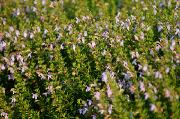 |
Satureja
x georgiana 'Desi Arnez' |
Winter
savory 'Desi Arnez' |
sun
|
N
We got this plant from Gail Barton who got it from Bob McCartney at
Woodlanders. Gail's husband, Richard, named it for his hero and Bob
is scratching his head. It is a great plant and we spent years telling
landscapers how nice it was as a full sun evergreen groundcover that
had a great fragrance in the leaves (which gives it the common names
"Georgia Savory" or "Desi Arnez Georgia Savory".
It must have light and drainage. Thus the "x": it has to
be a hybrid because our forms of the species are usually found in
filtered shade. I know botanists could give me a list of the differences,
and maybe who the papa was, but nurserymen are not that astute. Z-7; H-2'; sun; dry;evergreen; blue flower |
| Vitex Agnus-castus |
Chaste tree |
sun
|
B
Invariably
in summer we get calls to identify this little tree covered with purple
or blue blooms. It is a verbena so grows really well in the hot south.
Nice as a street tree or in a sunny yard. Can be pruned any way you
want. Fast grower. Salt tolerant. Many selections. Z-7; H-15'; sun; dry; purple flower |
|
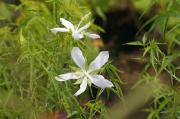 |
Hibiscus
coccinea 'Alba' |
Hibiscus, White flowered |
sun
|
White
flowered form of red star with same star shape blooms and deep cut
leaves. Z-8; H-5'; sun; wet/dry; white flower |
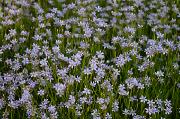 |
Sisyrinchium angustifolia | Blue eyed grass |
sun
|
N
A
lily with blue flowers that you can use instead of grass or liriope. H-6in; sun; dry; evergreen; blue flower |
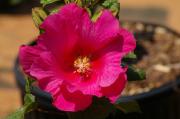 |
Hibiscus
x grandiflora 'Papa's' |
Hibiscus 'Papa's' |
sun
|
NB
Given to Thayer by a Baldwin county MG years ago that his Papa had
given to him. Probably cross between H. coccineus and H. grandiflora
which grows naturally at Gulf State Park. Very large, very bold pink
blooms all summer. Large leaves. Large plant. Z-8; H-5'; sun; wet/dry; pink |
| Hibiscus moscheutos | Hibiscus, Crimsoneyed Rosemallow |
sun
|
NB Large white flowers with rose center. We have enjoyed these at Lake Moultrie for years. | |
| Agapanthus
africanus 'Peter Pan' |
Lily of the Nile 'Peter Pan' |
sun
|
This native of Egypt has wonderful blue flowers in the spring and very easy to grow. The dwarf variety, 'Peter Pan' has smaller foliage and the blooms are only about 8 inches tall compared to the species that will have bloom spikes as tall as two feet. It prefers full sun and average soil. | |
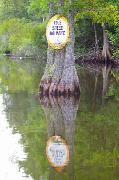 |
Taxodium distichum | Bald Cypress |
sun
|
This tree is truly 'King of the Swamp'. This deciduous tree is one of the best trees to have in a hurricane according to U.S. Forrestry Service statistics. The wood of this tree is prized for lumber but it sickens me to see people cut them down just to make mulch. The tree will grow almost anywhere and can take some pretty tough environments. It is a very good tree for many landscape uses and should be used more often. It is usually conical in form but you can see many different forms and shapes in her natural habitat. It loses its leaves in the fall so is perfect on the west side to help with the heating in the winter and keeping the building shaded in the summer. (See Taxodium distichum nutans for comparisons between "Bald Cypress" and "Pond Cypress") |
| Taxodium distichum nutans (syn. Taxodium ascendens) | Pond Cypress |
sun
|
A slightly smaller version of the "Bald Cypress" that has its needles pointing up instead of horizontal. This tree has the same great characteristics but it has less desire to put up "knees" in the landscape and can be planted closer to structures than the "Bald Cypress". We have three next to our office and they have been perfect. This is probably my favorite tree for more reasons than we can list here. | |
| Ternstroemia gymnanthera | Cleyera |
sun
|
This
oriental native is probably as much overused as Ligustrum and has
just about as many bad habits. Most of the other plants on this web
site that are the same size at maturity would be better suited. We
are starting to see it seed in to wild areas like privet. |
|
| Ternstroemia gymnanthera 'Emory' | Cleyera, 'Emory' |
sun
|
Dawrf
version. H-5'; sun; dry; evergreen; white flowers |
|
| Trachycarpus fortuneii | Palm, Windmill |
sun
|
One
of the most cold hardy of the palms. |
|
| Vaccinium asheii |
Blueberry, Rabbit-eye |
sun
|
N The favorite Blueberry in the south. There are many cultivars and hybrids of this plant and we grow some good old types that were developed over at Tifton, Georgia and two that Dad picked out from his seedlings. They flower in the early spring and different varieties produce fruit at different times, ranging from late May until late June (here in Mobile). They should be used in every landscape. Spring white bell shaped blooms, summer fruit, fall color, and winter form. They grow in sun or shade and moist or dry soils. | |
| Vaccinium asheii 'Brightwell' | Blueberry, 'Brightwell' |
sun
|
N
well
known selection H-6'; sun; dry; white flowers |
|
| Vaccinium
asheii 'Climax' |
Blueberry, 'Climax' |
sun
|
N
well
known selection from Climax, GA H-6'; sun; dry; white flowers |
|
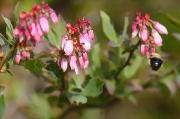
| Vaccinium
asheii 'Georgia Gem' |
Blueberry, 'Georgia Gem' |
sun
|
N
This
is the earliest to produce fruit. It would be hard to describe how
good this fruit tastes after waiting so long for fresh blueberries
in the spring, after most of the native azaleas have bloomed. H-6'; sun; dry; evergreen; white flowers |
| Vaccinium
asheii 'Premier' |
Blueberry, 'Premier' |
sun
|
N
well
known selection H-6'; sun; dry; white flowers |
|
| 'Pop's #2' | Blueberry, 'Pop's #2' |
sun
|
N
This
is one of the ones Dad picked based just on fruit quality. An excellent
choice. H-6'; sun; dry; white flowers |
|
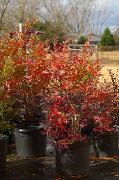 |
Vaccinium
asheii 'Red Red' |
Blueberry, 'Red Red' |
sun
|
N
This
is one of the ones Dad picked based just on fruit quality. Thayer
looked at it during the fall and it was in beautiful, red fall color
so she named it. Great food tree and great landscape appeal. H-6'; sun; dry; white flowers |
| Acer saccharum floridanum | Florida Sugar Maple |
sun
|
N
This tree is the first cousin to the northern Sugar Maples and has
the wonderful fall color that the species is famous for. Some show
red and most show a deep yellow in late fall. A great tree for the
south as we don't have a lot of plants that have great fall color.
Unlike many maples, this one isn't dependant on moist sites. It will
live almost anywhere and is a fairly rapid grower. Z-4 ; H-40'; sun; wet/dry |
|
| Liriope
muscari 'Big Blue' |
Liriope 'Big Blue' |
sun
|
Most
often used in a border, this Liriope is noted for its blue flowers
in little spikes. It can be used in a mass planting and will do well
in a sunny, well drained spot. Treat it like a lilly because that's
what it is. It is evergreen and spreading, although slowly. Z-6; H-18"; sun; dry; evergreen; purple flowers |
|
| Abies firma | Momi Fir |
sun
|
The
only Abies that will grow in the deep South. This slow growing Fir
is a native of Japan and the first one I saw was one that my father
had planted as a gift from Mr. K. Sawada. At the time, it was about
30 feet tall and strikingly attractive. When I asked how old it was,
I was told it was about 40 years. A great tree for the patient person
but I wouldn't get into the Christmas tree business with this one. Z-4; H-60'; sun; dry; evergreen |
|
| Hypericum densiflorum 'Creel's Gold' | Hypericum 'Creel's Gold' | N
This neat plant was given to us by Mike Creel while he worked for
South Carolina Wildlife Magazine. We were able to propagate it and
named it for him. It has the typical yellow flowers of all the "St.
John's Worts and will get to about 18 inches tall by 18 inches wide.
Blooms in May and spot blooms all summer. Some fall color. Full sun
to part shade. Nice in masses. Z-6; H-3'; sun/part sh; dry; evergreen; yellow flowers |
||
| Hydrangea
serrata 'Purple Tiers' |
Hydrangea 'Purple Tiers' |
sun/part
|
For the best description see the USDA one here. | |
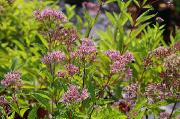 |
Eupatoriadelphus
fistulosus |
Joe Pye Weed |
sun/part
|
NB
Found in sunny, wet areas, usually utility easements. Can get to 8
feet and blooms purple in the fall. Perennial for a damp area that
needs a tall plant in the background. Great nectar host for swallowtail
butterflies. A smaller cultivar called 'Little Joe' is available.
Our front yard has this, Helianthus angustifolius and Vernonia gigantea
among others. It grows in one season from flat ground to blooming
over your head in the fall and full of life. It amazes guests. We
put up a temporary bamboo fence along the front walk to keep the path
clear. Fun. Z-6; H-5'; sun/part; wet/dry; pink flowers |
| Loropetalum
chinense 'Zhuzhou' |
Loropetalum 'Zhuzhou' |
sun/sh
|
See
somebody else's descriptions as I'm tired of talking about the many,
many forms of this plant. Z-6; H-20'; sun/sh; dry; evergreen; pink flowers |

© 2010-2019 Dodd & Dodd Nursery, Inc. All rights reserved.
questions?
comments? please contact
webmaster
site design and maintenance by Sweet
Apple Graphics

